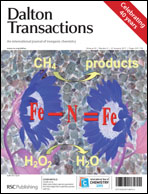Neutral mononuclear CuI complexes and their counterparts with counterion, i.e.Cu(qbm)(PPh3)2, Cu(qbm)(DPEphos), [Cu(Hqbm)(PPh3)2](BF4) and [Cu(Hqbm)(DPEphos)](BF4), where Hqbm = 2-(2′-quinolyl)benzimidazole, DPEphos = bis[2-(diphenylphosphino)phenyl]ether, have been synthesized and characterized by X-ray structure analyses. All of the four complexes in solid state exhibit a strong phosphorescence band in the orange spectral region at room temperature. The photophysical properties of these complexes in both methylene chloride solution and poly(methyl methacrylate) film have been studied. Compared to the related cationic complexes, the neutral ones show blue-shifted emissions and longer lifetimes that can be attributed to the additional ligand-centered π–π* transition beside traditional metal-to-ligand charge-transfer (MLCT). By doping these complexes in N-(4-(carbazol-9-yl)phenyl)-3,6-bis(carbazol-9-yl) carbazole (TCCz), multilayer organic light-emitting diodes (OLEDs) were fabricated with the device structure of ITO/PEDOT/TCCz: CuI (10 wt%)/BCP/Alq3/LiF/Al. The neutral complex Cu(qbm)(DPEphos) exhibits a higher current efficiency, up to 8.87 cd A−1, than that (5.58 cd A−1) of its counterpart [Cu(Hqbm)(DPEphos)](BF4).

You have access to this article
 Please wait while we load your content...
Something went wrong. Try again?
Please wait while we load your content...
Something went wrong. Try again?


 Please wait while we load your content...
Please wait while we load your content...